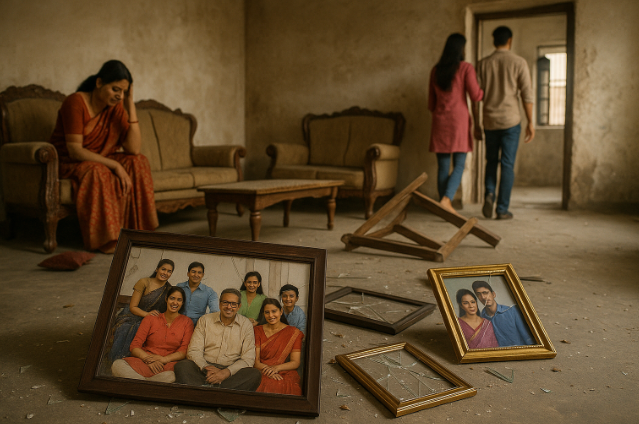
‘Vasudhaiva Kutumbakam’, the ideology that the world is one family and around which Indian households had been set up thousands of years ago, is dying in the 21st century. According to the 2011 Census, only 20% of households in India lived as a joint family. This is no small shift! From a time when people used to pass traditions, property, belongings, and more across generations to now living separately, this shift reflects deep transformations in values, career aspirations, and lifestyles. This article tries to explore the reasons behind the decline of the joint family system, which was once something that gave Indians a lot of pride and honour in the world.
Causes of This Disintegration
Like all things in existence in this universe, the erosion of the joint family system is not a sudden collapse but a gradual movement shaped by socio-economic, cultural, legislative, financial, and many other reasons.
Urbanisation and Industrialisation: The Industrial Revolution sowed the seeds for this decline. Industries were set up wherever resources were available in plenty. Consequently, cities formed near them, and people from rural areas migrated in large numbers to earn money. This resulted in people leaving their parents and relatives back in their villages since there wasn’t enough space in the cities to live with a large family.
Education and Individualism: Modern education has inspired the youth, especially women, to seek control of their lives, which they couldn’t have under the prevalent elderly-dominated joint family system. Most of the young adults today dream of living alone so that nobody tells them what to do. Sad, but that’s the reality. Individualism has created friction between the older generations and modern youth.
Economic Factors: Joint families thrived in agricultural setups where land and labour were shared. However, agriculture depended on the climate and is an uncertain activity. On the other hand, jobs are more stable and secure, encouraging youngsters to settle in cities. Besides, the hunger for profit, competition, private ownership, and promotion challenged the spirit of collectivity in joint families. And if some people ever tried to manage their extended family in the city, the cost of living and the apartment system made sure that the idea became impractical.
Cultural Influences: From India’s point of view, westernisation has played and is playing an important role in how people view joint family systems, with global media promoting nuclear family ideals, privacy, and independence.
Joint Family System’s Replacement
Things get replaced by something better, or at least something we feel is better. And we Indians have found numerous exciting ways to adjust between a nuclear family and a joint family.
The concept of a Nuclear Family System came up after the breakdown of the Joint Family System. Smaller, self-contained units, with just parents and children, now dominate urban India. This system provides autonomy, privacy, and flexibility, but comes with its drawbacks, mostly emotional. You still are your parents’ child, and you can’t just leave them in your hometown. This makes people visit their family and relatives several times a year, which seems exciting on one hand, but also hectic on the other. Besides, grandparents and their grandchildren are people who shouldn’t be kept away from each other. Grandparents can instil values and knowledge in the children, and keeping them away just leads to isolation. The fact that both parents or even one parent works all day outside can take an emotional toll on children.
Another system or plan that has been developed in India is a merger of both the Nuclear and Joint Family Systems. In cities like Pune, Bengaluru, and Kolkata, extended families are living in the same city itself. Some even live in adjacent societies, and a few even live a floor or two above each other! In this way, both the elders and young people enjoy the benefit of privacy and comfort, while still staying connected effortlessly. This ‘near but not under one roof’ model preserves emotional attachment while giving space for personal boundaries.
The use of the internet in the 21st century has allowed the joint family system to continue digitally. No problem if you can’t visit your parents or bring them to your home. They are just a video call away! WhatsApp chatting, video calling, and more features allow dispersed families to stay connected and conduct online pujas, enjoy birthday celebrations, and participate in festivals. While digital warmth can’t replace physical presence, it offers continuity in an age of mobility.
Reclaiming Roots
India’s traditions have survived invasions, migrations, westernisation, and more, and the joint family system is trying to do the same. It's not merely a household type with tens of people living together; it’s a philosophy of coexistence, it’s a kind of ritual, where the focus is on the ‘we’ and not the ‘I’ as in nuclear families. Despite the rise of nuclear families and urban migration, the joint family system continues to offer something irreplaceable: emotional support. We all need someone whom we can bank on in times of crisis and celebration. In a nuclear family, you are all by yourself. But in a joint family, you have people ready to walk hand in hand and act as moral anchors. But then again, nuclear families have their benefits as well. You can venture into your fields of interest without the pressure of following what your relatives say and what your ancestors did. You can even increase your standard of living by planning and managing your financial loads properly since the resources utilised in a Nuclear Family are much less than those in a Joint Family.
Challenges do exist in both cases, but they also show up with opportunities for negotiation, joint growth, and emotional maturity. As India moves ahead, the joint family system reminds us that progress does not mean leaving your people and isolating yourself, but making sure you adjust—the special skill of Indians!
